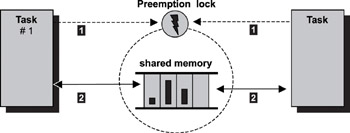Книга: Real-Time Concepts for Embedded Systems
15.6.3 Resource Synchronization
Разделы на этой странице:
15.6.3 Resource Synchronization
Multiple ways of accomplishing resource synchronization are available. These methods include accessing shared memory with mutexes, interrupt locks, or preemption locks and sharing multiple instances of resources using counting semaphores and mutexes.
Shared Memory with Mutexes
In this design pattern, task #1 and task #2 access shared memory using a mutex for synchronization. Each task must first acquire the mutex before accessing the shared memory. The task blocks if the mutex is already locked, indicating that another task is accessing the shared memory. The task releases the mutex after it completes its operation on the shared memory. Figure 15.13 shows the order of execution with respect to each task.

Figure 15.13: Task-to-task resource synchronization-shared memory guarded by mutex.
Shared Memory with Interrupt Locks
In this design pattern, the ISR transfers data to the task using shared memory, as shown in Figure 15.14. The ISR puts data into the shared memory, and the task removes data from the shared memory and subsequently processes it. The interrupt lock is used for synchronizing access to the shared memory. The task must acquire and release the interrupt lock to avoid the interrupt disrupting its execution. The ISR does not need to be aware of the existence of the interrupt lock unless nested interrupts are supported (i.e., interrupts are enabled while an ISR executes) and multiple ISRs can access the data.

Figure 15.14: ISR-to-task resource synchronization- shared memory guarded by interrupt lock.
Shared Memory with Preemption Locks
In this design pattern, two tasks transfer data to each other using shared memory, as shown in Figure 15.15. Each task is responsible for disabling preemption before accessing the shared memory. Unlike using a binary semaphore or a mutex lock, no waiting is invovled when using a preemption lock for synchronization.

Figure 15.15: Task-to-task resource synchronization-shared memory guarded by preemption lock.
Sharing Multiple Instances of Resources Using Counting Semaphores and Mutexes
Figure 15.16 depicts a typical scenario where N tasks share M instances of a single resource type, for example, M printers. The counting semaphore tracks the number of available resource instances at any given time. The counting semaphore is initialized with the value M. Each task must acquire the counting semaphore before accessing the shared resource. By acquiring the counting semaphore, the task effectively reserves an instance of the resource. Having the counting semaphore alone is insufficient. Typically, a control structure associated with the resource instances is used. The control structure maintains information such as which resource instances are in use and which are available for allocation. The control information is updated each time a resource instance is either allocated to or released by a task. A mutex is deployed to guarantee that each task has exclusive access to the control structure. Therefore, after a task successfully acquires the counting semaphore, the task must acquire the mutex before the task can either allocate or free an instance.

Figure 15.16: Sharing multiple instances of resources using counting semaphores and mutexes.
- 15.4 Resource Synchronization Methods
- 10.4 Synchronization and Messaging Tools
- 3.1. CLOCK SYNCHRONIZATION
- 10.2.3. Synchronization
- Chapter 15: Synchronization And Communication
- 6.4.1 Wait-and-Signal Synchronization
- 6.4.2 Multiple-Task Wait-and-Signal Synchronization
- 6.4.3 Credit-Tracking Synchronization
- 6.4.4 Single Shared-Resource-Access Synchronization
- 6.4.5 Recursive Shared-Resource-Access Synchronization
- 6.4.6 Multiple Shared-Resource-Access Synchronization
- 15.2.1 Resource Synchronization




